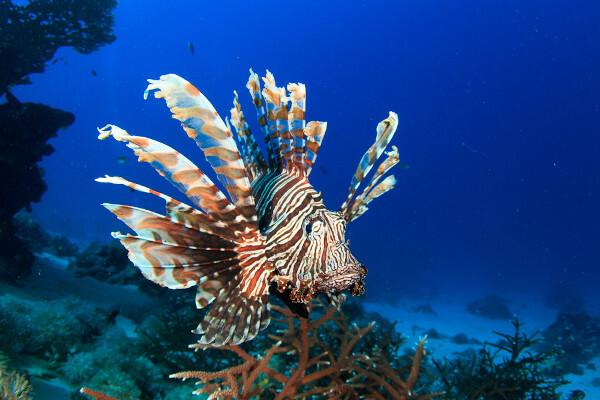Lion-fish is a popular name assigned to species originating in the Indo-Pacific of the genus Pterois. The species stands out for the presence of white and red-orange vertical stripes and extended rays on its lateral and ventral fins.
It is a more active species at dawn and dusk, usually observed on reefs. During the day, it rests or moves slowly over the substrate. the species has 18 poisonous thorns, being this poison capable of causing nausea, pain and convulsions in human beings. In Brazil, it is considered a invasive species and worries environmentalists due to the fact, for example, that it has no natural predators, preys on native species and poses a risk to human health.
Check it out on our podcast: Challenges of conserving Brazilian biodiversity
Topics in this article
- 1 - Summary about the lionfish
- 2 - Characteristics of the lionfish
- 3 - Feeding the lionfish
- 4 - Reproduction of the lionfish
- 5 - Habitat of the lionfish
- 6 - The dangers of invasive species
- 7 - Accidents with lionfish in Brazil
lionfish summary
Lionfish is the popular name given to different species of fishes venomous marines of the genus Pterois.
Its body is full of stripes and extended rays on its lateral and ventral fins.
It has 18 poisonous spines.
It is a carnivorous species.
It is an invasive species in our country, and its multiplication can cause predation of native species, compromise fishing production and even pose a risk to human health.
Accidents with this species can cause pain, nausea and even convulsions.
Do not stop now... There's more after the ad ;)
Characteristics of the Lionfish
lion fish is the popular name given to different species of venomous marine fish of the genre pterois, being the species Pterois volitans the most known. This species of fish is characterized by having a striking coloration, standing out for the presence of white and red-orange vertical stripes. Lionfish also have extended rays on their lateral and ventral fins. They can grow up to 47 centimeters.
Being venomous animals, lionfish have 13 spines on their dorsal fin, one on each fin. pelvic and three in the anal fin, totaling 18 spines that are capable of inoculating the toxin that produce. In humans, the venom can cause pain, nausea and convulsions.
During the day, the fish usually moves slowly close to the substrate or remains at rest. THE species is most active at dawn and to the dusk. Sunset represents the best time for lionfish to feed, as it is a period of great movement in the Recife, when several species are returning for rest and protection in place.
Read too: The venom of marine catfish — another poisonous fish that can cause accidents
lion fish feeding
the lion fish feed, mainly, in invertebrate animals, such as shrimp and small fish. To get its food, the animal remains motionless on coral reefs until prey passes through it. It then attacks the victim and swallows it through suction. According to ICMBio, a lionfish is able to eat 20 fish in half an hour and to feed on animals almost their own size.
lion fish breeding
Solitary in habit, the lionfish only joins other individuals at the time of reproduction. This fish reproduces at high rates, which characterizes another problem when observed on our coast. According to ICMBio, the species can lay about 30,000 eggs.
lion fish habitat

the lion fish is ocean native Indian and Pacific, where it is usually observed associated with reefs. It was seen for the first time in Atlantic, in the Florida region, in 1985, being attributed its appearance in the region due, probably, to the release of individuals that were in aquariums. Some researchers link the fish invasion in the United States to Hurricane Andrew, in 1992, which was responsible for breaking an aquarium located by the sea.
In Brazil, the fish was sighted for the first time in 2014, in Arraial do Cabo, Rio de Janeiro. The most likely hypothesis is that the lionfish arrived in Brazil through Ocean currents of the Caribbean, where it is also known as an invasive species. The exchange of fish species between Brazil and the Caribbean is already a well-known event. The possibility that the invasion occurred due to the release of these animals that were in aquariums is also not ruled out.
Read too: Ecological relationships — the interactions of living things with each other and with the surrounding environment
The dangers of invasive species
Many people do not understand the risks that an invasive species can pose to the environment. However, it is important to keep in mind that a species, when introduced into a new environment, can find conditions for it to develop in an uncontrolled way, such as easy access to food and lack of predators. When multiplying excessively, the invasive species may compete for resources with native species, for example, and compromise the biodiversity local.
In the case of lionfish, a rapid invasion process has been observed. In addition to affecting biodiversity, it is believed that this species can harm fishing, tourism and even compromise the health of human beings, since it is a poisonous species. Lionfish consume large amounts of fish, which poses a danger to our native and endemic species.
Lionfish accidents in Brazil
The lionfish is an invasive species, and its occurrence has been recorded in our country since 2014. Starting in late 2021, the fish began to be seen more frequently. The first accident involving this animal, however, only occurred in the year 2022.
The fisherman Francisco Mauro da Costa Albuquerque, 24 years old, was the first Brazilian to have an accident with this fish in national territory. In April 2022, the individual had his foot pierced by the animal's spines, and the venom caused pain, fever and convulsions. The fisherman needed to be hospitalized.
Although reports of accidents are rare, it is important to be aware. If there is an accident with this animal, it is recommended that the place where the spines penetrated be immersed in hot water for about half an hour to 40 minutes. It is important that the individual is taken to a hospital so that the injury can be evaluated and medications can be prescribed.
By Vanessa Sardinha dos Santos
Biology teacher



